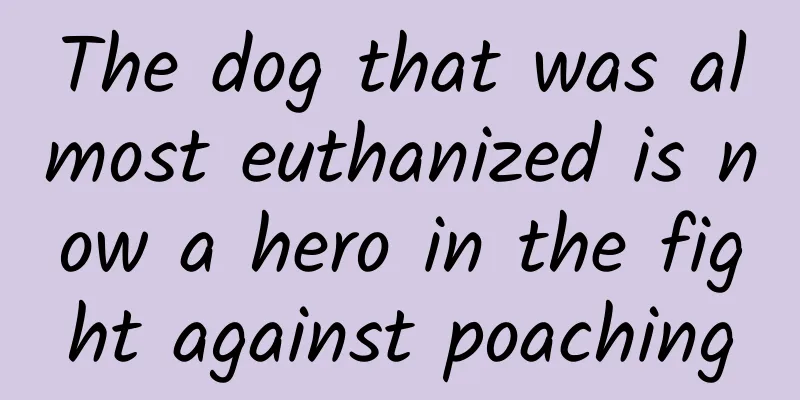The dog that was almost euthanized is now a hero in the fight against poaching

|
There is always a gray mood hanging over the shelter. This is a space of mixed noise and dead silence. A puppy named Ruger hides in a corner, perceiving the outside world sensitively and with a bit of hostility. Ruger once had a home, but the owner brutally shot a litter of dogs. Ruger survived but suffered vision damage. In addition to physical defects, Ruger was prone to biting people, which led to almost no family willing to adopt him . Ruger is a Labrador retriever and German shepherd cross | The Guardian As the number of stray animals increases, the remaining dogs in shelters are becoming scarce. If the dogs that come to the shelter early are not adopted, their lives will end with euthanasia . In the United States, about 1.2 million dogs in shelters are euthanized every year. However, Ruger's life did not stop there. Ruger would not have thought that a few months later, he would become the first anti-poaching working dog in Zambia . His footprints would be all over the tops of mountains and along the banks of streams and rivers. He used his keen sense of smell to create miracles one after another. Parker and WD4C What changed Ruger's fate was an organization called Working Dogs for Conservation (WD4C) and one of its founders, Megan Parker. Parker and another working dog, Pepin, in training | WimbergProductions / Youtube After getting a master's degree in ecology, Parker worked in Yellowstone National Park in the United States, responsible for a project to reintroduce wolves. In order to track the wolves, they need to locate the wolf's excrement , but this is not easy. In order to quickly locate the target in such a large area and minimize the impact of human activities, Parker thought that the best "candidate" might be a dog . And it makes sense: Dogs have highly developed olfactory receptors , giving them an incredibly sensitive sense of smell; they can even tell when there's a spoonful of sugar dissolved in a swimming pool. Dogs have an extremely sensitive sense of smell | In 2000, Parker and other partners founded WD4C to train and use dogs for environmental protection. Unlike most working dogs that are carefully bred, trained since childhood, and strictly screened, WD4C's working dogs are mostly dogs that were eliminated from their original jobs or left the shelter . Many dogs in the shelter, including Ruger, have one thing in common: they are too energetic . When they are puppies, they are active and appear lively, smart and lovable. But when they grow up, their excessive activity becomes a burden to their families and becomes a reason for people to abandon them. Dogs in shelters | Mahdikarimi70 / Wikipedia Commons But in the eyes of WD4C, being energetic is an advantage for dogs . In order to recruit dogs suitable for reconnaissance work, trainers visited many animal shelters with balls and toys , looking for dogs who are always energetic, self-driven and obsessed with toys. It was at this time that Ruger was noticed by WD4C. Go to school and learn skills! Initially, Ruger wasn't the most suitable candidate: he had a bad temper, refused to go into a cage, and Parker had trouble getting him to the vet. But Parker never gave up on him. She felt that Ruger's energy and drive would make him a great working dog. Parker tried to improve Ruger's character while training him professionally, with the main focus on teaching dogs to track scents . In the early stages, the trainer will hide toys and objects with the target scent in the same place , allowing the dog to establish an association between the scent and the toys; in the later stages, the trainer will separate the scent and the toys , but if the dog finds the scent, the trainer will still give the dog the toy as a reward. With this incentive, the dogs were able to complete specific tasks such as finding wolf feces and other species by smell. Working dogs in training | Great Big Story / Youtube Trainers can also change different scents , and smart dogs will quickly understand that it is just a change of name, so it is not difficult to light up a new skill tree. But just like when humans play games, they often unlock a hero first, and then practice the hero by playing more games; dogs have a similar situation - although they can learn to identify a new smell within a day, they still need weeks of actual practice to consolidate this new skill. When working in the wild, trainers also need to find ways to keep the dog interested . For some very rare and difficult to locate species, trainers often manually place a few samples to prevent the dog from getting unhappy and losing interest in serious work due to not being able to find the target for too long. In fact, training is a two-way street: both working dogs and handlers need to learn how to work with each other | WD4C Becomes Zambia's first anti-poaching working dog After training for a period of time, Ruger started his first job - cooperating with a Zambian law enforcement force to combat poaching . On his first day at work, Ruger and the soldiers searched the convoys passing through the checkpoint . If it were a manual search, it might take more than an hour to search a car, but the dogs only needed three or four minutes. Ruger in search of its target | WD4C As the vehicles passed by one by one, the Luger suddenly sat still and stared at one of them. This was its "alarm", indicating that it had detected the target's scent. The soldiers immediately opened the car door and after a search, they found a matchbox wrapped in a plastic bag, which contained a primer: the thief used it to ignite the propellant in the machine gun. After completing the mission, Ruger will be rewarded with his beloved toy | The Guardian Although Ruger's vision is impaired, this defect has not become a stumbling block on his work . Other dogs are easily distracted by their surroundings, but Ruger can always focus on the smell . Today, Ruger is still working in Zambia, and he is also the country's first anti-poaching working dog. He lives next to the South Luangwa National Park, where illegal trapping, hunting and trading of wild animals occur every day . Ruger's mission is to find illegal wildlife products such as ivory and rhino horns, as well as smuggled guns and ammunition. Left: Confiscated ivory products Right: Ruger's colleagues and their trainers | WD4C Paw Patrol has done a great job! WD4C has trained more than 200 dogs , and their work locations span 15 countries on five continents. In addition to Luger's work, WD4C dogs are also assigned to prevent invasive species and monitor rare species . Working dog work content displayed on the WD4C official website | wd4c.org Tule, a Belgian Malinois, once served in the U.S. Army Special Forces, but was eliminated because of his gentle temperament and his unwillingness to bite people . (Probably because they were afraid that he would be too gentle to criminals... In addition, this article also introduces more outrageous reasons for the elimination of police dogs.) WD4C used his long-lasting excitement and keen sense of smell to arrange him to monitor black-footed ferrets (Mustela nigripes). Left: Working hard! Right: Taking a selfie while slacking off (wrong) | Elizabeth Stone The black-footed ferret was once declared extinct, but in 1981, a dog killed a black-footed ferret on a ranch in Wyoming, USA, and people learned that the animal was not extinct. Even after 40 years of protection, the black-footed ferret is still endangered. The endangered black-footed ferret | USFWS Mountain-Prairie / Wikipedia Commons Tulai is part of the effort to protect the black-footed ferret. Whenever Tulai tracks the scent of a black-footed ferret, it "notifies" researchers so they can map the species' distribution . Without Tulai, researchers would have to use cameras and live animal traps to study this elusive little creature, neither of which has proven to be very reliable. Tulai in the sun | WD4C Orbee, a border collie, has a globetrotting career. In Alberta and Montana, it monitors zebra mussels (Dreissena polymorpha) and quagga mussels (D. bugensis), both invasive freshwater shells that clog water pipes, making repairs expensive, and cling to docks, boats and anchors, disrupting normal human activity. Obi on the Lawn | WD4C In California, Obie monitors the distribution of the San Joaquin fox (Vulpes macrotis mutica). This fox is found only in the San Joaquin Valley and is endangered because its habitat has been largely converted to farmland. With the help of Obie and other dogs, scientists have created a distribution map of the San Joaquin fox; local governments use this map as a reference when planning solar projects to avoid destroying the remaining habitat. And in North Africa, it helps scientists count the Cross River gorilla (Gorilla gorilla diehli), a subspecies of the western gorilla that is the most endangered species due to habitat destruction and hunting. Swipe left and right to view: Shipwreck covered with zebra and quagga mussels, San Joaquin fox, Cross River gorilla | Wikipedia Commons "They love their work. When they are out on the field, you can feel their excitement and happiness. They really enjoy this kind of life," Parker said. For these dogs, a small and comfortable living room is not their ideal home. Running between heaven and earth can fully display the physique and talent given by God. Professionally trained vs. half-way through In the public's impression, the selection of working dogs is often very strict. Not only are there requirements for breed and pedigree, but they also have to receive training from a young age and go through multiple levels of selection. Will the "business ability" of these dogs who have changed careers be different from those of professional dogs? In fact, working dog breeding is not to find one or two excellent individuals, but to improve the entire breed or strain , so that the probability of excellent individuals increases. When a dog is a puppy, it cannot fully demonstrate whether it has the qualities to be competent for the job, so cultivating an excellent working dog strain can reduce the waste of resources caused by the training process. Professionally trained police dogs | West Midlands Police / Wikipedia Commons As for adult dogs, their qualities have already been demonstrated. Regardless of whether they come from a "prestigious family" of working dogs, as long as they can meet the indicators (often including body size, courage, excitability, etc.), they are promising talents. But to become a WD4C detection dog, you have to go through a series of assessments. In addition to the above indicators, the dogs also need to compete in endurance, cooperation, self-confidence, concentration , etc. Given that dogs need to take various means of transportation when they go out on duty, sometimes trucks, helicopters, and even elephants, their adaptability is also particularly important. There are still many challenges to successfully join the company | WD4C What about those dogs who fail to pass the assessment? Don't worry, if the dogs are not hired in the end, WD4C staff will volunteer to find a permanent home for them. We will always remember On the WD4C official website, there is a section dedicated to commemorating the dogs who have passed away, where their photos, names, and birth and death years are displayed. Some of them have been hurt by humans, like Ruger mentioned at the beginning. But in the end they still chose to trust humans, and fought side by side with us on the front line of environmental protection, doing things that we think are great. These loyal and brave little guys deserve to be remembered forever, as the poem quoted on the official website says: When the man woke up, he said, "What is that wild dog doing here?" "His name is no longer Wild Dog," the woman replied, "but our most important friend. And that will remain forever." Section on the official website to commemorate deceased working dogs | WD4C Note: Although a few dogs in shelters are lucky enough to become rescue dogs, please do not abandon your dog at will. Before raising a dog, please carefully consider whether you can afford to raise it; after raising it, please always be responsible for it. References [1]https://www.theguardian.com/lifeandstyle/2016/mar/08/ruger-american-dog-stopped-african-poachers [2]https://thebark.com/content/working-dogs-conservation-profile-co-founder-megan-parker [3]https://news.mongabay.com/wildtech/2017/12/training-detection-dogs-for-conservation/ [4]https://www.nationalgeographic.com/animals/article/working-dogs-for-conservation [5] He Yong, Hao Wenquan, Chen Zhanjun. Basis of working dog breeding[J]. China Working Dog Industry, 2017. [6] https://wd4c.org/ [7]https://ideas.ted.com/once-unwanted-these-dogs-are-now-on-the-front-lines-of-wildlife-conservation/ Author: Siyi Editor: Mai Mai This article comes from the Species Calendar, welcome to forward If you need to reprint, please contact [email protected] |
<<: How "empty" is an empty stomach? Can't you eat milk and bananas on an empty stomach?
>>: Kaifeng, an underestimated ancient capital?
Recommend
Go to Ningxia and unlock the treasure world!
Ningxia Definitely beyond your expectation Treasu...
Guangzhou Distribution Mini Program Mall, how long does it take to produce a distribution mini program?
As of now, the number of mini programs has reache...
Beware! This commonly used medicine increases the risk of fractures and diarrhea!
Expert of this article: Pan Kunming, Master of Ph...
Wang Zheng's "Gestalt Psychotherapy" 60 lessons, from entry to mastery
Training course video content introduction: This ...
2020 Zhihu promotion and traffic generation skills!
Choice is greater than effort? No comment. I don’...
How to analyze Baidu search term report? How do I analyze the search terms report?
Bidding is a game of spending money to buy traffi...
APP advertising: How to choose the right delivery channel?
If you don’t advertise, you’re waiting for death;...
After being hit by bird poop, I discovered a "shocking" secret!
Have you ever been hit by bird poop? I don't ...
Why is Erlitou the Summer Capital? Traveling 5,000 years to explore China's "First Dynasty"
One day 4000 years ago The mythical hero Dayu Pas...
Stop complaining about me being unsophisticated, it's because I'm so charming
Silicon, the chemical element with the second hig...
What procedures are required for the Foshan local classified information mini program?
With the increasing popularity of mini programs, ...
PPTV Quantum Dot TV 65Q900: Pursuing the Ultimate Performance Experience in the Concept of Design First
When TV sets began to be more integrated into the...
Google just released a tool to crack into your iPhone
Google released a powerful tool this morning to h...









